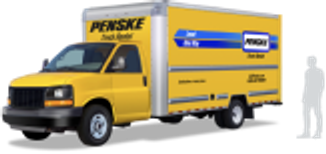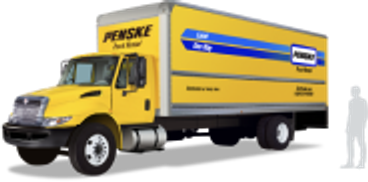10 Rental Driving Tips

Before getting behind the wheel of your rental truck, it’s important to know some basics about driving a bigger vehicle. Whether you’ve never driven a moving truck or haven’t moved in years, the experts at Penske Truck Rental are here to help with tips to get you from point A to point B without worry.
1. Use the Right Fuel
Not sure how to fuel a rental truck? There’s a big difference between gas and diesel, so check under the sun visor, on the driver’s side door, or on the sticker near the fuel tank to see what fuel your vehicle needs. Using the correct type of fuel optimizes your rental vehicle’s performance and efficiency and helps prevent breakdowns along the way.
2. Check the Weather
Consider travel conditions, pack an emergency kit and obey local travel restrictions during severe storms. In addition to a moving day survival kit or emergency kit, consider including extra blankets, water, and non-perishable snacks for longer journeys, winter driving, or other inclement weather. Speaking of bad weather, use weather forecasting apps or websites to stay updated on current and potential weather conditions along your route.
3. Adjust Your Mirrors
Be sure to regularly adjust mirrors throughout your trip to maintain optimal visibility. Make sure you can see the road around you and behind you. Familiarize yourself with the blind spots of your rental truck and be extra cautious when changing lanes or maneuvering in tight spaces. Use your mirrors to back up slowly, and if someone is with you, ask them to guide you from a safe position outside the truck.
4. Know Your Vehicle Height
Your moving truck’s clearance height is posted on the windshield and at the front corner radius of the vehicle box. But before setting off on your journey, plan your route using GPS or navigation apps that offer height clearance information, which can help you avoid low bridges or overpasses. Also, be aware of low-hanging tree limbs and wires, drive-thrus, and changes in elevation, such as steep inclines or declines, which may affect the vehicle’s clearance. Lastly, if you’re not sure the truck will fit, safely pull off to the side of the road and double-check the clearance before proceeding.
5. Drive Smart
Driving a moving truck can initially feel different than what you’re used to, so allow for more space when turning, be sure the road is clear before changing lanes, and ensure you have enough space when parking your vehicle. You can also minimize the risk of accidents by practicing defensive driving techniques, such as scanning the road ahead and anticipating potential hazards. And lastly, familiarize yourself with the vehicle’s features before starting your trek, read the owner’s manual as needed, and don’t speed.
6. Avoid Tailgating
Trucks and vans weigh more than cars and need more time to stop. Always keep four car lengths behind other vehicles and more when driving in wet weather or during the winter months. In addition, use turn signals well in advance when changing lanes and avoid abrupt maneuvers to keep you and everyone safe on the road.
7. Know Weigh Stations, Tolling and Other Rules
Your vehicle may be subject to weigh station requirements, so research specific regulations regarding commercial vehicles in every state/province you’ll be traveling through to ensure compliance with weight restrictions. If you’re unsure whether your vehicle needs to be weighed, play it safe and stop – you’ll be waived through if you don’t need to be there.
You’re also responsible for paying toll fees and any fines or penalties related to parking, traffic, operating, and moving violations that occur during your rental period. In addition, be aware of restrictions in areas marked “no trucks,” and keep important documents, such as registration and insurance papers, easily accessible in case of roadside inspections.
8. Secure Your Vehicle
Stay safe during your drive by closing all doors properly. For trucks, turn the rear cargo door latch clockwise to lock and counterclockwise to open. For vans, close the left door, followed by the right. Always perform a thorough check of all doors and latches before departing to prevent cargo from shifting or doors from opening during transit. Use additional security measures, such as padlocks or cargo straps, for valuable or fragile items to prevent theft or damage. And of course, be sure not to lock your keys in the vehicle.
9. Keep Passengers Inside the Cab
Do not allow passengers to ride inside the back of the truck, even if you’re planning to drive slowly or a short distance. Sudden stops or shifts in weight can quickly cause injury, so passengers should only ride in the truck cab. Ensure all passengers wear seat belts and are seated securely within the cab to minimize the risk of injury in the event of a collision.
10. Download Our App
Download the Penske App and explore the app’s features, such as 24/7 roadside assistance, how-to videos, and more, to enhance your rental experience and stay connected. And don’t forget to enjoy the journey with our ultimate moving day playlist.

You've decided to move. Now what? We have the planning, packing, loading, and driving tips you need to make your move a success.
Explore NowRecent Articles













